English Needles from the 1850s
Melanie at Catbird Studios just did a post on needle facts, and she mentioned, “By 1847 with the introduction of specialty machinery, more than 50 million needles were made each week in the Redditch district of England.” She also mentioned that she was having a hard time finding out about needle history in the US.
I knew I had a packet of needles from 1857, and when I looked, sure enough they were from Redditch!
When I followed the link Melanie gave to the article by Kate McLaren at National Gallery of Victoria, there was a lot more history of Redditch and their needles, and one quote piqued my interest: “The eye of the Redditch needle was apparently so small that a modern day thread is not fine enough to pass through, other than specifically fine Sutures.”
Although they apparently made finer needles, a modern thread goes through the ones I have just fine. Amy Alan points out how these needles have better features than modern needles for hand-sewing. The feature that sounds best to me, is that the head of the needle is the same size as the blade, leading to less resistance in going through fabric. I will have to try them out!
Reading the history made me want to know more about H. Milward and Sons. I found these trade cards online at Digital Commonwealth.
.
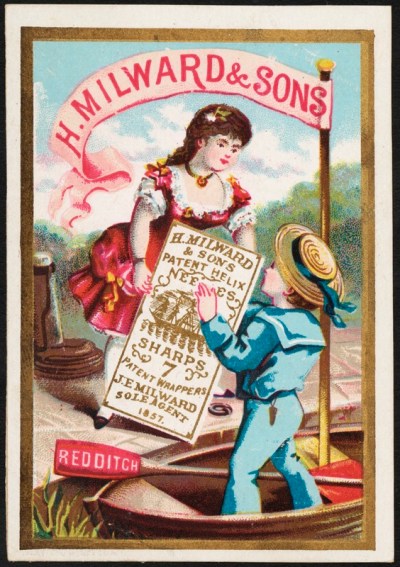
Needle trade card from Digital Commonwealth. Source.
According to Wikipedia, the Milward company was eventually renamed Needle Industries. The Clark thread that they recommended was merged with the Coats company to become the famous Coats & Clark, and in 1973, Needle Industries was sold to Coats!
Here is a link to a copy of the salesman sample book for H. Milward needles that is for sale — it can be yours for only $500!
But more in line with most of our budgets, here is an 1862 book online at the Internet Archive, The History and Description of Needle Making.
So thanks, Melanie, Kate, and Amy, for making me take a closer look at a little package of needles I’ve had for 20 years!
(I would also like to say that I thought this post was going to take me about 2 minutes to write. But my camera was downstairs, so I thought I would quickly just scan the package of needles for an image. But I forgot that my printer/scanner is old and has been giving me error messages that I have the wrong print head. Which I don’t. And tech support has told me that it is probably not worth it to get another printer head, because the printer is 5 years old, so any other part could go at any time.
And even though I wanted to use the scanner, and the problem is with the printer, the whole machine wouldn’t work. And when I opened it up to try to clean the printer head again, the paper of needles fell off the scanner bed and through the rear paper slot, into the depths of the machine, between various paper rollers and separators, and I couldn’t even see them in there. Getting needles out of the proverbial haystack would have been easier, because you can pull a haystack apart, and then go over the hay with a big magnet. But printers are not made so that ordinary humans can take them apart.
But there was no way that I was going to let needles that had made it for 160 years perish in the depths of a stupid printer, so I went downstairs — the same stairs I was too lazy to go down to get my camera — and got a bunch of screwdrivers, and took it all apart. And it took me 2 hours. But I got the needles back. The printer, I am pretty sure, has gone on to its planned obsolescence home in the sky, as its designers hoped. Hmmm, 1857 design vs. 2012 design.)
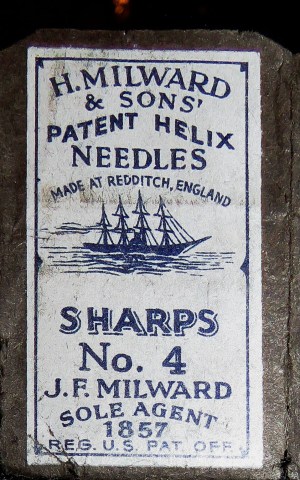
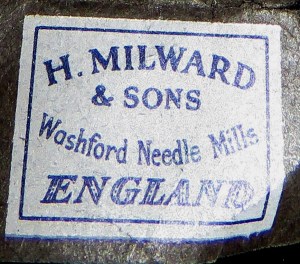
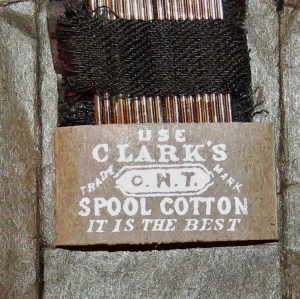
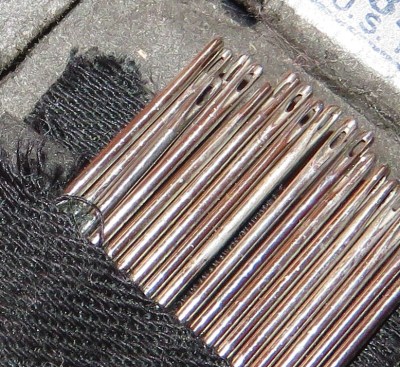
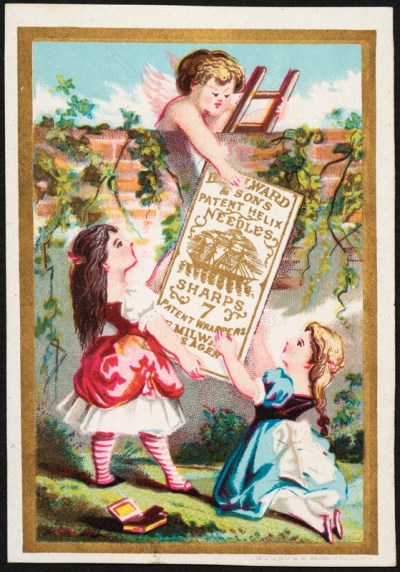
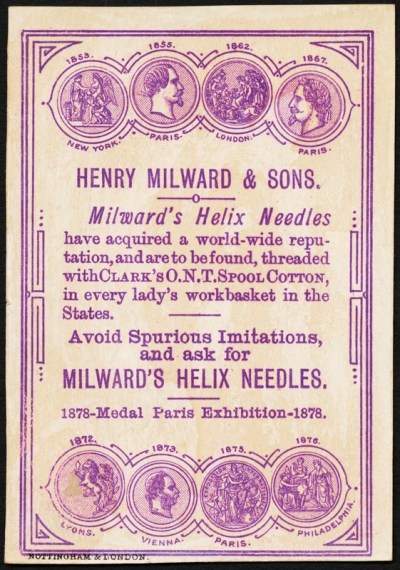
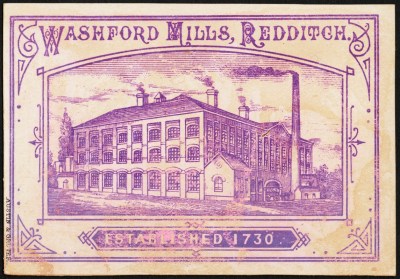














Reblogged this on Catbird Quilt Studio and commented:
Wow, what a great, interesting follow-up to my simple post about needles! Take a look at Gwen the Textile Ranger’s post about her packet of English needles, circa 1857. Thanks, Gwen! (Please leave comments and Likes at her post!)
I have had days like that – many days. Loved hearing about your 100+ plus needles. When I was tutoring Costume History I had a student who wanted to know about the history of scissors – well that goes back about 1,000 years and it transformed costume. SO it was good to read about the needles. Didn’t know anything about needle history until now, and I have a doctorate in textiles! So much for education.
Well, don’t you think it is that textiles is such a huge field, you can’t possibly even dip into all its permutations? I have been working with sewing needles since I was 5, and I never knew about their history until now myself.
Thank you for stopping by!
Oh my, too bad about the printer. However since it already was past its useful life, I’d say the sacrifice to get your needles back was worth it.
THANK YOU SO MUCH for this fascinating post! I love the trade cards, and the short corporate history of Milward ==> Coats.
A part of the history you didn’t include (nor did I) was that of the pointers. Those employees whose job was to shape and refine the needle points had a bad lot. The metal particulate as well as the dust from the grindstone combined to give them lung disease, and few survived their 30s.
I know, I hated to leave out the workers, but I thought about them toiling away in that huge factory that was on the trade card.
But it was supposed to be a TWO MINUTE POST. (not that I have ever actually written one of those.) I was going down more rabbit holes and it was getting later….
I started to read that online book and it was very sympathetic toward the seamstresses — I will have to return to that.
Very interesting posts by you two.
I am glad Melanie started me down this path! 🙂
Leave it to you to research the subject further–it’s what we count on you for! And the story about the printer resonated on so many levels–made me laugh out loud but I’m very glad you saved the needles. Not that I ever worried you wouldn’t!
If only I had remembered that famous saying, “A stitch in time saved nine,” and at least had thought to pull the needle package off the scanner bed before opening the lid! 🙂
Oh no about the printer escapade. That would have happened to me. Lovely and interesting piece that was new to me. Thank you for sharing.
I love the meticulous care and fascinating content in your posts. Thank you for this. And sympathy for the needles/printer episode- that sinking sensation as you watch it unfold:)
Thank you, what a nice thing to say! And you described it perfectly when you said “sinking feeling!” 🙂
Im intrigued. Thanks for sharing.
I enjoyed seeing those needles, so I’m glad you got a good picture (finally!). And yes, I don’t think we’ll find many early-21st-century items lasting nearly as long.
Wow, I have some of those! And in a little padded ‘book’ that said Silver Eyes and yes from Ridditch!! Some other needles I have in little black paper folders, no name, do have eyes that are indeed way too small for our modern thread. Thank you for this rabbit hole!!
I do go down so many rabbit holes, I am thinking of changing my blog title to “Alice in Textileland.” 🙂
For want of a nail… Fascinating that needles made over 100 years ago are still functional, but that printer is history. Too bad you didn’t make a video of you fishing out the packet from the printer’s bowels. I’d pay good money to see that.
It was a painfully slow process. I am much better at putting things together than at figuring out how to get them apart.😊
Your natural determination came through clearly here. I never thought about needles having an interesting history, but they do! Thank for writing about this.
It’s like that old saying “See a pin and pick it up and all day long you’ll have good luck.” I could never understand why someone would want a pin! But in the old days when they were hard to come by, that would have been a lucky thing to find. (Plus I guess you were saving someone else from having bad luck by stepping on it.) 🙂
I have included your blog in INTERESTING BLOGS in FRIDAY FOSSICKING at
http://thatmomentintime-crissouli.blogspot.com.au/2017/04/friday-fossicking-28th-april-2017.html
Thank you, Chris
We have needles from 1857 in the original pack. That is 160 years old. I would like to know what the value of this package is. Proud to have it.
Isn’t it amazing they lasted so long?
I don’t know the value, my mom bought me this pack at an antique store back in the 1990s. I think she paid a few dollars back then.
I am looking for any information on Essington Needles.
Hi Anna, I checked two resources I know of, The History and Description of Needle Making from 1862, and Tracing Your Textile Ancestors by Vivien Teasdale (which focuses on the UK) from 2009. Neither book mentions Essington Needles. Sorry I can’t be of more help, but I hope I at least saved you the time you would have spent in looking at those resources. 🙂